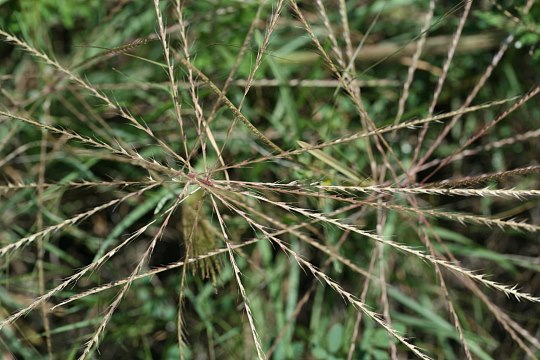Description: This perennial grass is ½–1¼' tall and tufted at the base, consisting of fertile and infertile shoots. Fertile shoots have 2-4 alternate leaves along the lower-third of the culm, while infertile shoots have about 4 leaves that are sheathed together in the shape of a fan. The culms are pale green to tan, somewhat flattened, glabrous, and unbranched. The leaf blades of fertile shoots are about 2 mm. across and 3-4" long; they are light blue-gray to pale green, hairless, and ascending to spreading. The leaf blades of infertile shoots are the same as those of the fertile shoots, except they are often somewhat longer (up to 6½" in length). The leaf sheaths are light blue-gray to pale green, hairless, and membranous along their margins; they are often rather loosely attached to their culms. The ligule at the junction of each blade and sheath has a papery membrane and a few white hairs.

Each fertile shoot terminates in a large inflorescence up to 5½" tall and 11" across. This inflorescence has 2-4 whorls or near-whorls of floral spikes along its central axis (or rachis). The lower to middle whorls of spikes are widely spreading, while the upper spikes are ascending and somewhat shorter in length. Each floral spike is up to 5½" long; small spikelets are distributed bilaterally along its length. Each spikelet is 3-4 mm. long (excluding the awns) and V-shaped at the base; it has a pair of glumes, a fertile lemma, and an infertile lemma. One glume is 2-3 mm. long, while the other glume is 3-4 mm. long; they are narrowly lanceolate and keeled. The fertile lemma is 2-3 mm. long and folded along its length; at the apex, it has an awn about 5-8 mm. long. The infertile lemma is 1.5–2 mm. long, folded along its length, and obtuse or truncate at its apex, where there is an awn about 3-4 mm. long. The florets of fertile lemmas are perfect with 3 anthers and 2 stigmas. In Illinois, the blooming period occurs during the summer, lasting about 1-2 weeks for a colony of plants. The florets are cross-pollinated by the wind. The spikelets are initially green to reddish green, but they later turn tan or brown when the grains become mature. At this time, the entire inflorescence may break off and tumble in the wind, thereby distributing the grains. The root system is fibrous and rhizomatous; sometimes rootlets form along the lower nodes of the culms. Where there is little competition from other vegetation, this grass often forms clonal colonies.

Cultivation:
Preferred growing conditions are full sun and dry barren soil
containing gravel, clay, or sand. Because of its low growth habit, this
grass can adapt to a regimen of mowing.
Range & Habitat:
The adventive Windmill Grass is still uncommon in Illinois (see Distribution
Map), although it is probably becoming more abundant,
especially in sandy areas of the state. This grass is native to the
southern Great Plains and grassy areas of southwestern United States.
Habitats include dry upland prairies, dry sand prairies, gravelly areas
along railroads and roadsides, lawns, and barren waste areas.
Faunal Associations:
Little is known about the floral-faunal relationships for this grass,
particularly in Illinois and other Midwestern states, where it is
adventive. The foliage of Windmill Grass is eaten by the American Bison
in the southern Great Plains, and it is probably edible to other hoofed
herbivores as well. Various sparrows, doves, and other
granivorous birds may eat the seeds, but this is speculation on my part.

Photographic
Location:
A gravelly area along a railroad track in Champaign, Illinois.
Comments:
The inflorescence of this little grass has the shape of a windmill or
television antenna. Windmill Grass (Chloris
verticillata) superficially resembles one of
the common crabgrasses (Digitaria spp.), but its
inflorescence has more vertical depth with 2-4 whorls of spikes along
the central axis (or rachis). The inflorescence of the typical
crabgrass is more digitate with a single whorl (or near-whorl) of
ascending spikes. Also, the spikelets of Windmill Grass have awns,
while those of crabgrass are awnless. Another grass species, Finger
Grass (Chloris
gayana), is adventive from Africa and it is quite
rare in Illinois. This grass is much taller (often exceeding 3' in
length) and
its inflorescence is more digitate. Other Chloris spp.
haven't been observed in Illinois; like Windmill Grass, many of these
grasses
are native to the southern Great Plains and grassy areas of the desert
southwest. These latter species tend to be smaller in size than
Windmill
Grass, and their spikelets have shorter awns (less than 4 mm. in
length) or they
lack awns altogether.